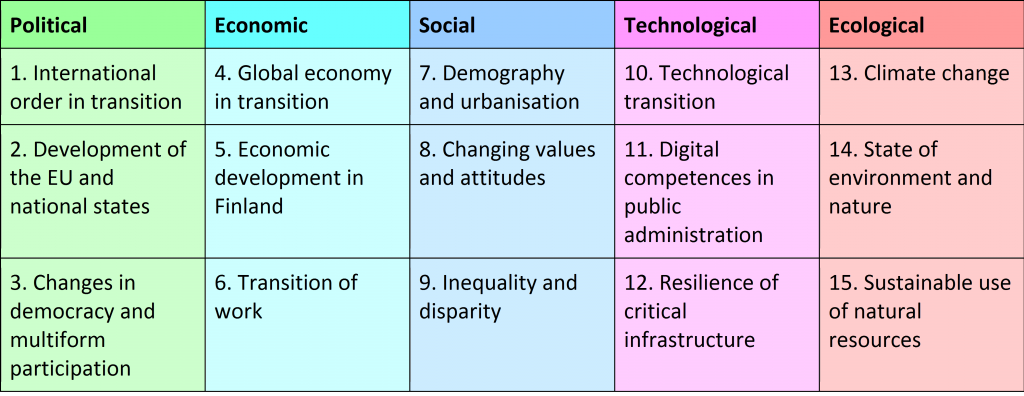The Prime Minister’s Office in Finland published in late 2017 a list of change factors of the global landscape, with the aim to familiarise decision-makers as well as citizens with the changes and uncertainties we will face in the future. The result of fifteen key factors of change was produced in collaboration with experts across ministries and their strategy work. They also provide the basis for dedicated futures outlooks by various ministries to be published later in 2018.
The fifteen change factors each introduce the identified change and describe the situation until 2030. Additionally, alternative paths and development directions are offered. Rather than predictions, the change factors help prepare for various alternatives around the identified change topics, all the while acknowledging uncertainties.
In this signal post, the fifteen change factors are briefly analysed in the context of the platform economy. The idea was to formulate statements as questions and portray the alternative ways the change factor may be expressed in the platform economy. Some of the change factors can act as high level trends that steer platform development from afar, whereas others have very straightforward impact mechanisms. On the other hand, platforms themselves can influence the change factors and contribute to how the changes take place. The objective of this analysis is to help to map the potential with the platform economy regarding both opportunities and threats in the changing societal landscape. In fact, as the platform economy evolves, any of the issues identified may take a positive or negative turn or a combination of the two.

Political
- International order in transition
- Will the USA host as the basis for leading platform companies?
- Can China and the rest of Asia challenge the US leadership?
- Will platforms act as enabling tools in international policy-making?
- Will platforms be used as enabling tools for conflicts and corruption?
- Development of the EU and national states
- Will the EU develop into a competitive and uniformly close-knit platform economy?
- Could we face a failure of joint EU activities in the platform economy?
- Are there going to be nationally or regionally confined platform economies?
- Changes in democracy and multiform participation
- Will platforms act as enablers of accessible knowledge and the information society?
- Will platforms be used to spread polarisation and misinformation?
- Will platforms be employed as tools to societal participation in democracy?
Economic
- Global economy in transition
- Are we going to see globally reigning platform monopolies or local platform economies?
- Is the economic growth from platforms around the world going to be even or uneven?
- Will platforms support quick profits or sustainable growth?
- Economic development in Finland
- Will Finland succeed as a balanced platform economy on its own?
- Is Finland going to excel in its niche areas in the global platform economy?
- Will Finland remain a minor actor in the platform business?
- Transition of work
- Is all work going to be gig work on platforms?
- Could education, training and skills be provided on platforms on an on-demand basis?
Social
- Demography and urbanisation
- Can platforms bring along a counter-trend to urbanisation and migration?
- Could platforms help to solve challenges related to ageing?
- Will platforms be used as connectors between culturally or demographically differing groups?
- Changing values and attitudes
- How will ethics and values be incorporated into platforms?
- Could different platforms support variability in choices on lifestyles and values?
- Will platforms be used as a destructive force?
- Inequality and disparity
- Will platforms be employed to empower women and build equal opportunities globally?
- Will platforms be used to aggravate polarisation of individuals and nations?
- Can platforms contribute to accessible human health and wellbeing?
Technological
- Technological transition
- Will blockchain, AI, robots, etc. be employed successfully in platforms?
- Is the role of platforms and advanced technologies to be in control or as a subordinate?
- Could we face technological underachievement and failure of the platform economy?
- Will data be the currency of the future technological platforms?
- Digital competences in public administration
- Will the public sector be active in platform management and participation?
- Is public administration going to be incapable of deploying digital platforms in their own processes?
- Can the public sector keep up with platform markets?
- Resilience of critical infrastructure
- Will platforms bring intelligence into infrastructure management?
- Will we be able to ensure resilience regarding digital infrastructures and cyber security?
Ecological
- Climate change
- Could platforms and advanced technologies contribute to effective agreements in climate policy?
- Will digital platforms increase or decrease the overall environmental burden?
- Could the platform economy provide the means to survive with climate change impacts?
- State of environment and nature
- Could platforms facilitate monitoring of natural and built environments?
- Sustainable use of natural resources
- Could platforms be used as enabling tools for material and resource management, e.g. recycling?
- Will sharing platforms promote effectively sustainable, resource-efficient lifestyles and economies?
- Will unsustainable consumption patterns spread uncontrollably because of platforms?
- Are platforms, data and related technologies going to increase energy consumption exceedingly?
Selected articles and websites
Demographic factors in the platform economy: Gender
Often it may feel like we are all anonymous and equal in the online world, but at other times age, gender and other demographic and socio-economic factors seem to matter greatly. In this signal post, we discuss gender in the context of the platform economy. (See also previous post focussing on age.) What is the gender balance among platform users? Who designs and programs platforms? And what is the role of user behaviour and online culture?

Why is this important?
Platform economy has potential to support societal integrity by providing an abundance of opportunities to women and men alike. For example, gig work enabled by digital platforms brings flexibility regarding working hours and location, which is assumed to benefit stay-at home parents, who under other circumstances would stay outside the workforce.
Zooming into platform user populations, in social media usage, Uber passengers and consumers of the on-demand economy there has been found little or no difference in the US in the numbers of women and men. Sounds good! However, if we look at Uber drivers, as much as 86% are male. The exact opposite situation is found with a marketplace for handmade and vintage goods Etsy, where out of the 1.5 million sellers 86% are female. Could it be that platforms reflect and replicate the existing biases and traditions when it comes to the division of labour between women and men?
Another central point of interest is for whom platforms are designed. And who designs them? The inherent male-dominance in the software industry and venture capital is reflected in platforms in that it is dominantly men who design and make decisions about how platforms function. A characteristic example of challenges in this area is the recent controversy over a Google employee manifesto, which shows that despite efforts to increase diversity, old attitudes are very much alive.
An equally important question is how people behave and treat one another when using platforms. A case in point is the numerous incidents of online harassment and doxing (e.g. maliciously gathering and releasing private information about a person). One alarming example from video game culture gone astray is the Gamergate controversy. Online culture also shows in reputation and rating systems, where disclosing of background information such as gender may influence behaviour unfairly.
Things to keep an eye on
For new as well as existing platforms, the topic of gender is an important aspect of consideration in platform design. User strategies can at best pinpoint specific gender-related needs and provide targeted and tailored solutions. Platform owners should also acknowledge the responsibility and equality points of view to ensure the platform welcomes all unique users and treats them on an equal footing. Underlying algorithms as well as the culture of the user population should support equal opportunities and broadmindedness.
Also, it will be increasingly important for governments to keep gender equality in view when promoting digitalisation agendas, especially to involve women. Nations do face different types of challenges based on cultural context and nuances as well as status in financial and technological development, and some recommendations on how to harness women’s potential are given in a recent study.
Selected articles and websites
Harvard Business Review: The On-Demand Economy Is Growing, and Not Just for the Young and Wealthy
Pipes to platforms: How Digital Platforms Increase Inequality
GlobalWebIndex: The Demographics of Uber’s US Users
Uber: The Driver Roadmap
Pew Research Center: Social Media Fact Sheet
Pew Research Center: Online Harassment 2017
Poutanen & Kovalainen (2017): New Economy, Platform Economy and Gender
CNNtech: Storm at Google over engineer’s anti-diversity manifesto
Watanabe et al. (2017): ICT-driven disruptive innovation nurtures un-captured GDP – Harnessing women’s potential as untapped resources
Wikipedia: Gamergate controversy
European Parliament, Think Tank: The Situation of Workers in the Collaborative Economy
openDemocracy: Back to the future: women’s work and the gig economy
Demographic factors in the platform economy: Age
Intuitively thinking online platforms seem to be all about empowerment, hands-on innovation and equal opportunities. In the digital world, anyone can become an entrepreneur, transform ideas into business and, on the other hand, benefit from innovations, products and services provided by others. But how accessible is the platform economy for people of different age? And how evenly are the opportunities and created value distributed? Some fear that platforms are only for the young and enabling the rich get richer while the poor get poorer.
In this signal post, we discuss age in the context of the platform economy. In future postings, we will explore other factors such as gender and educational background.

Why is this important?
When it comes to ICT (Information and Communication Technology) skills and adoption, the young typically are forerunners. For example, social media platforms were in the beginning almost exclusively populated by young adults. But studies show that older generations do follow, and at the moment there is little difference in the percentage of adults in their twenties or thirties using social media in the US. And those in their fifties are not too far behind either!
Along with the megatrend of aging, it makes sense that not only the young but also the middle-aged and above are taking an active part in the platform economy. Some platform companies already acknowledge this, and tailored offering and campaigns to attract older generations have been launched for example in the US. In Australia, the growing number of baby boomers and pre-retirees in the sharing economy platforms, such as online marketplaces and ride-sourcing, has been notable. Explanatory factors include the fact that regulation and transparency around platform business have matured and sense of trust has been boosted.
One peculiar thing to be taken into account is that many platforms actually benefit from attracting diverse user segments, also in terms of age. This shows especially in peer-to-peer sharing platforms. The user population of a platform is typically heavy with millennials, who are less likely to own expensive assets such as cars or real estate. Instead, their values and financial situations favour access to ownership. But the peer-to-peer economy cannot function with only demand, so also supply is needed. It is often the older population that owns the sought-after assets, and they are growingly willing to join sharing platforms. Fascinating statistics are available, for example, of Uber. As much as 65% of Uber users are aged under 35, and less than 10% have passed their 45th birthday. The demographics of Uber drivers tell a different story: adults in their thirties cover no more than 30%, and those aged 40 or more represent half of all drivers. In a nutshell, this means that the older generation provides the service and their offspring uses it.
Things to keep an eye on
In the future, we expect to see more statistics and analysis on user and producer populations of different types of platforms. These will show what demographic segments are attracted by which applications of the platform economy as well as which age groups are possibly missing. The information will help platforms to improve and develop but also address distortion, hindrances and barriers.
It may also be of interest to the public sector to design stronger measures in support of promoting productive and fair participation in the platform economy for people of all ages. Clear and straightforward regulation and other frameworks will be important to build trust and establish common rules.
Selected articles and websites
GlobalWebIndex: The Demographics of Uber’s US Users
Growthology: Millennials and the Platform Economy
Harvard Business Review: The On-Demand Economy Is Growing, and Not Just for the Young and Wealthy
INTHEBLACK: The surprising demographic capitalising on the sharing economy
Pew Research Center: Social Media Fact Sheet
Pipes to platforms: How Digital Platforms Increase Inequality
Uber: The Driver Roadmap
